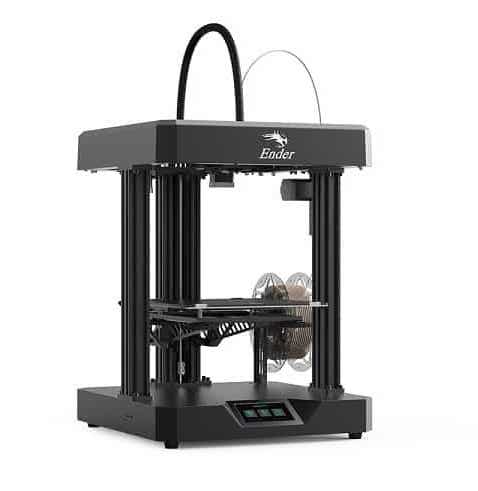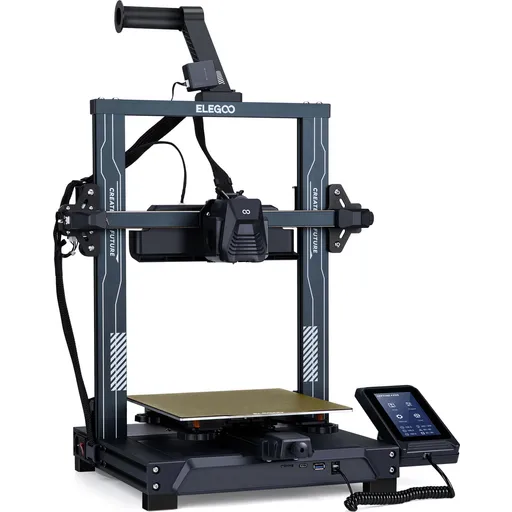Compare Ender 7 vs Neptune 4 PRO
Comparison between the best 3D printers
Choose the best 3D printer at the best price. The cheapest 3D printers are here.
Buy a 3D printer here with 3D Fila.
 |
 |
|
| Model | Ender 7[BUY Ender 7] |
Neptune 4 PRO |
| Printing Material | Filament | Filament |
| Buy Filament for Creality 3D Ender 7 | Buy Filament forElegoo Neptune 4 PRO | |
| Estimated price | $429,00 | $359,00 |
| Manufacturer | Creality 3D | Elegoo |
| Release Year | 2021 | 2023 |
| Print Volume [mm] | 250x250x300 | 225x225x265 |
| Printer Size [mm] | 430x460x570 | 475x445x515 |
| Weight [kg] | 17,2 | 8,9 |
| Power Loss Recovery | YES | YES |
| Enclosed printer | NO | NO |
| Bed Leveling | Manual | Automatic |
| Filament End Sensor | YES | YES |
| Bed type | Heated | Heated |
| Power supply system | Bowden | Direct Drive |
| Standard nozzle | 0,4 | 0,4 |
| Maximum Nozzle Temperature [°C] | 260 | 300 |
| Maximum Bed Temperature [°C] | 100 | 110 |
| Maximum printing speed [mm/s] | 250 | 500 |
| Filament holder | YES | YES |
| Camera for supervision | NO | NO |
| Recommended filaments | PLA, PETG, Tritan, Flex, ABS | PLA, PLA+, TPU, PETG, Nylon, ABS |
| Recommended slicers | Cura, Simplify, Slic3r, IdeaMaker | Bambu Studio, Super Slicer, Cura, Prusa Slicer, Orca |
| Maximum Resolution [mm] | 0,1 | 0,1 |
| Processor | Creality CR-FDM V.2.4.S1_V101 32bits | ARM 64 bit |
| Display | Display touchscreen 4,3'' | Touchscreen 4,3'' |
| Power Supply | 110/220V / 350W | 310 W |
| Connectivity | SD / USB | USB, microSD |
| Operating systems | Windows, Mac, Linux | Windows, Linux, Macbook |
| Date of registration in the system | 2022-11-04 | 2024-07-02 |
| Release date | 2021 | 2023 |
| Extra features | Crealitys Ender 7 printer offers remarkable print speeds, utilizing CoreXY kinematics for precise and fast movement. With a 250x250x300mm build area, dual direct extruder, and custom hotend, the Ender 7 is capable of printing at high speeds, although quality may suffer on smaller prints. Assembly is relatively straightforward, but the machine is noisy and can get hot. Its true speed potential is most noticeable on larger prints, where it outperforms its competitors. | The Elegoo Neptune 4 Pro stands out for its advanced features, including pre-installed Klipper firmware, a dual-gear direct extruder with a 5.2:1 ratio, a high-temperature nozzle (up to 300°C), a flexible magnetic PEI platform, efficient cooling fans, and a 121-point auto-leveling system. The printer also features a 4.3-inch touchscreen interface, dual linear bars on the X and Y axes, and a segmented heated bed for energy savings. |
| Support for multiple colors and materials (AMS and CFS) | NO | NO |
Notes * |
||
| Cost-benefit | 7 / 10 | 7 / 10 |
| Hardware | 2 / 10 | 2.8 / 10 |
| Tela | . | . |
| Print volume | 4 / 10 | 3 / 10 |
| Performance | 2 / 10 | 4 / 10 |
| [BUY Ender 7] |
Conclusion |
| In conclusion, when comparing the Creality Ender 7 and the Elegoo Neptune 4 Pro, each printer presents distinct advantages tailored to different user needs. The Ender 7 shines with its larger print volume and impressive maximum printing speed, making it an ideal choice for projects requiring quick turnaround times on larger prints. However, it may sacrifice some print quality, particularly on smaller models, and features such as manual bed leveling could be seen as a drawback for users favoring ease of use. On the other hand, the Neptune 4 Pro, being a newer model, incorporates advanced technologies such as automatic bed leveling and a direct drive extruder, which allows for better material handling and a wider range of filament compatibility. Its reduced weight and more compact design enhance its portability, while it also boasts a higher maximum nozzle temperature, catering to users interested in utilizing a broader spectrum of materials. Considering their respective prices, the Neptune 4 Pro offers a solid cost-benefit ratio, making it suitable for those prioritizing technology and versatility without significantly compromising print volume. While the Ender 7 may appeal to users seeking larger prints and faster speeds, they should weigh this against its overall user experience and potential noise levels. Ultimately, the choice between the two will depend on specific user requirements—whether that be speed and size with the Ender 7 or advanced features and ease of use with the Neptune 4 Pro. |

